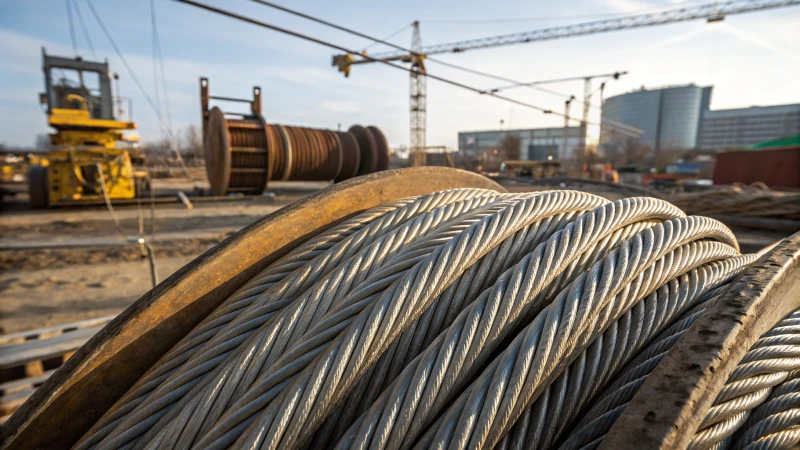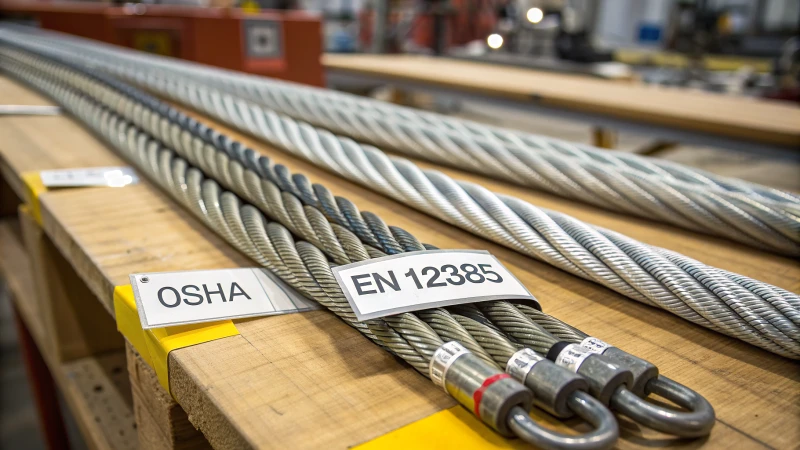
Have you ever wondered how to gauge the strength of steel wire ropes that hold up massive loads?
To calculate the breaking strength of a steel wire rope, apply the formula BS = D² × R × K, where D is the diameter in millimeters, R is the nominal tensile strength in N/mm², and K is a rope-specific factor based on construction. This provides a reliable estimate of the rope's capacity.
I remember standing at a construction site, feeling the weight of responsibility as I watched cranes lift heavy beams. The safety of everyone around depended on those steel wire ropes. That’s when I realized understanding their breaking strength wasn’t just about numbers; it was about lives.
The formula is straightforward, but there’s more to it than just plugging in numbers. Safety standards and advanced modeling tools can significantly enhance accuracy. Dive into these additional methods to ensure you’re choosing the right wire rope for your needs, and keep those operations both safe and efficient.
Breaking strength formula uses rope diameter in inches.False
The formula uses the diameter in millimeters, not inches.
Advanced modeling tools improve breaking strength accuracy.True
Modeling tools provide more precise calculations by considering additional variables.
How Do Construction Factors Affect the Breaking Strength?
Ever wondered why some steel ropes hold up under pressure while others snap?
Construction factors such as material composition, diameter, tensile strength, and design critically impact the breaking strength of steel wire ropes. By tweaking these elements, you can significantly boost both durability and performance.

Material Composition and Diameter
When I first started learning about steel wire ropes, I was amazed at how much the material composition influences their breaking strength. Imagine a high-grade stainless steel1 rope in your hands; it’s like holding the promise of strength and durability. These ropes are known for their corrosion resistance, making them invaluable in harsh environments. And here’s something I discovered: the rope's diameter plays a crucial role too. Larger diameters usually mean the rope can bear more load, which is a relief when you're relying on them to lift something heavy.
Tensile Strength and Design
Tensile strength is like that invisible force that keeps everything together until it can't anymore. In my early days on the job, understanding this was a game-changer. It varies based on the steel grade, directly affecting performance. Then there's the design aspect—take a 6×19 or a 6×36 construction. The difference? A 6×36 has more wires per strand, offering better flexibility and load distribution. But here's the catch—it might not be as strong as a 6×19 construction. It's all about finding the right balance.
| Design | Flexibility | Load Distribution | Breaking Strength |
|---|---|---|---|
| 6×19 | Moderate | Standard | Higher |
| 6×36 | High | Enhanced | Moderate |
Environmental Conditions
Picture this: you’re out at sea, and the salty air is biting at your face. The ropes you're using need to resist saltwater corrosion, right? That's where environmental conditions come into play. Moisture and extreme temperatures can weaken steel wire ropes over time. So, using galvanized steel2 or protective coatings is like giving them armor.
Application-Specific Adjustments
Every application is unique—just like how I need different tools for various tasks around the house. Ropes used in mining3 face rough handling and heavy loads, so they need enhanced abrasion resistance and toughness. Meanwhile, in construction projects, flexibility and load distribution are key to managing diverse lifting operations.
By grasping these construction factors, procurement managers can make informed decisions about selecting steel wire ropes that guarantee safety, reliability, and efficiency in their industry applications.
Stainless steel ropes resist corrosion better than galvanized ones.True
Stainless steel offers superior corrosion resistance compared to galvanized steel.
A 6×36 rope design has higher breaking strength than a 6×19.False
A 6×19 design generally has higher breaking strength than a 6×36.
What Safety Standards Should Be Considered When Choosing Wire Rope?
Choosing the right wire rope isn't just about ticking boxes—it's about ensuring safety, reliability, and peace of mind. Let's dive into what really matters.
When selecting wire rope, prioritize understanding load capacity, breaking strength, and compliance with standards like OSHA and EN 12385. Factor in construction type, environmental conditions, and specific application needs to ensure safety and efficiency.

Understanding Load Capacity
I remember the first time I had to choose a wire rope for a construction project. It was a bit overwhelming—so many numbers and specifications! But one thing I learned quickly was that understanding load capacity is absolutely crucial. This isn't just a technical detail; it's about ensuring that the rope can handle the weight safely. You calculate this by considering the breaking strength4 and applying a safety factor, typically between 5:1 and 8:1. For me, getting this right means avoiding sleepless nights worrying about potential mishaps.
Regulatory Compliance
I once attended a workshop where we dived into regulatory compliance—think OSHA in the U.S. or EN 12385 in Europe. These standards are like a safety net, ensuring that wire ropes are used effectively across industries. Following these guidelines isn't just about ticking a box for compliance; it's about safeguarding lives and equipment.
Construction Type and Environment
Choosing the right construction type of wire rope is like picking the right tool for the job. When I worked on a project near the coast, I realized how important it was to select ropes that wouldn't corrode in a marine environment5. Galvanized or stainless steel became my go-to options. Here’s a quick reference:
| Rope Construction | Flexibility | Strength | Best Use |
|---|---|---|---|
| 6×19 | Medium | High | General lifting |
| 6×36 | High | Medium | Cranes |
Application-Specific Factors
Every industry has its quirks. For example, I’ve learned that mining operations require ropes that are exceptionally durable and wear-resistant. This taught me that tailoring my choices based on industry needs isn't just smart—it's essential.
Importance of Testing and Validation
I've been amazed at how advanced modeling tools, like finite element analysis (FEA), have transformed our understanding of wire ropes' breaking loads by considering localized stresses. It's one thing to calculate theoretically, but validation through actual tensile testing brings peace of mind that everything checks out in real-world applications.
Understanding these safety standards isn't just part of the job—it's about ensuring everything runs smoothly and safely. By adhering to these standards, we reduce risks and protect both people and investments.
Wire rope load capacity includes a 10:1 safety factor.False
The typical safety factor for wire ropes is between 5:1 and 8:1.
OSHA sets standards for wire rope safety in the US.True
OSHA provides guidelines to ensure safe use of wire ropes in industry.
How Can Advanced Modeling Tools Enhance Calculation Accuracy?
Ever wonder how cutting-edge tools can transform your calculation accuracy from decent to spot-on?
Advanced modeling tools like finite element analysis (FEA) and machine learning dramatically enhance calculation accuracy by replicating real-world scenarios and detecting intricate patterns. These tools empower more precise forecasts and decisions across engineering, finance, and data analysis.

I remember the first time I realized just how game-changing advanced modeling tools could be. It was during a project where the stakes were high, and accuracy was everything. We were faced with the daunting task of predicting material performance under various conditions. That's when finite element analysis (FEA) came into play.
The Role of Finite Element Analysis (FEA)
Finite Element Analysis (FEA) is like having a crystal ball for engineers. It breaks down complex objects into smaller parts to simulate how they'll behave under various stresses—without a single drop of sweat from physical testing. It's like a safety net that caught us when we needed to ensure reliability in critical applications6, reducing the risk of failure before anything even went live.
Leveraging Machine Learning for Enhanced Predictions
But let's not forget the magic of machine learning. I was amazed at how it could sift through mountains of data, recognizing patterns that were invisible to the naked eye. By training these models on past data, we could make predictions with pinpoint accuracy. Imagine being able to forecast financial trends and avoiding those costly errors that used to keep us up at night! Those neural networks just keep getting smarter, refining their accuracy over time7.
Combining Tools for Greater Precision
The real revelation came when we combined FEA with machine learning. While FEA gave us insight into physical stress behaviors, machine learning helped us predict the optimal conditions for those stresses. In a field like construction, this combination was our secret weapon for creating safer, more reliable designs.
Here's how they play together:
| Tool | Application | Benefit |
|---|---|---|
| Finite Element Analysis | Structural engineering | Simulates physical stress on structures |
| Machine Learning | Predictive analytics | Identifies optimal stress conditions |
Incorporating these technologies has made me a firm believer in their ability to enhance reliability8 and efficiency across various fields. With every project, I find myself relying more on these powerful allies to deliver precision and excellence.
FEA reduces physical testing needs.True
FEA simulates conditions, minimizing the need for physical tests.
Machine learning is irrelevant in engineering.False
Machine learning predicts optimal conditions, aiding engineering designs.
Why Is Experimental Validation Important for Ensuring Reliability?
Ever had that moment when theory meets reality and things just click? That's the magic of experimental validation.
Experimental validation is vital because it verifies theoretical predictions through practical testing, ensuring accuracy and reliability. This process uncovers errors, refines methods, and confirms that scientific outcomes are dependable and applicable across real-world scenarios.

Understanding Experimental Validation
Imagine you're an engineer crafting a new design. On paper, everything checks out—the math, the simulations, the projected outcomes. But, if you’re like me, there's always that lingering doubt: "Will it really work out there in the wild?" That's where experimental validation9 steps in. It’s the bridge from concept to reality, where ideas face the ultimate test against real-world data. I remember a project where we were testing the breaking strength of steel wire ropes. The theoretical numbers promised they could handle extreme loads, but only by physically testing them did we truly know they’d hold up in the field.
The Role of Reliability in Scientific Research
In science, reliability isn't just a buzzword; it's the backbone of trust. Ever tried baking a cake only to find that following the recipe doesn't always guarantee success? Research can be like that too. Without experimental validation, findings might be one-hit wonders—impressive once but elusive to reproduce. Through rigorous testing, researchers ensure their results aren't just flukes but dependable truths. Think about civil engineering projects where safety standards are non-negotiable. Multiple tests ensure materials consistently meet those standards, preventing potentially catastrophic failures.
Practical Applications: A Case Study
Let’s dive into an example: designing a steel wire rope to withstand 100 kN. On paper, it’s flawless, but as I learned firsthand, those calculations need more than just theoretical backing—they need real-world proof through experimental validation. We ran tensile tests simulating the exact conditions these ropes would face.
| Stage | Action |
|---|---|
| Initial Testing | Conducting small-scale load tests |
| Stress Analysis | Using FEA to predict stress points |
| Real-world Testing | Simulating actual usage conditions |
Through such processes, we unearthed discrepancies between expectations and reality—insights that let us tweak and perfect the final product.
Diverse Perspectives on Validation
Different industries have their own take on what reliable data means. Take Emma in mining10: for her, durability against harsh conditions is non-negotiable. Meanwhile, in construction, John's focus is on safety standards. In both cases, experimental validation is the common denominator ensuring that theory translates to practice seamlessly.
By appreciating these perspectives, I see how experimental validation not only cements reliability but also tailors itself to each industry's unique demands, ensuring theoretical models hold up when put to the test.
Experimental validation ensures model accuracy.True
Experimental validation tests models against real-world data, confirming accuracy.
Theoretical predictions alone guarantee reliability.False
Without experimental validation, theoretical predictions may not reflect reality.
Conclusion
Learn how to calculate the breaking strength of steel wire ropes using a specific formula, considering factors like diameter, tensile strength, and construction for safety and efficiency.
-
Stainless steel offers excellent corrosion resistance and maintains tensile strength in harsh environments, enhancing the durability of wire ropes. ↩
-
Galvanized steel provides an extra layer of protection against rust and corrosion, improving the longevity of wire ropes in outdoor conditions. ↩
-
Steel wire ropes in mining need special features like abrasion resistance and durability to handle tough conditions and heavy loads. ↩
-
Explore methods for calculating wire rope breaking strength to ensure safe load handling. ↩
-
Learn about corrosion resistance of galvanized ropes in marine settings. ↩
-
Discover how FEA helps predict material behavior under stress, reducing failure risk. ↩
-
Learn about the adaptive nature of neural networks and their increasing accuracy with experience. ↩
-
Explore how combining FEA and machine learning improves calculation reliability. ↩
-
Explore how experimental validation ensures engineering designs meet real-world demands. ↩
-
Learn about durability's role in ensuring mining equipment performs well. ↩

